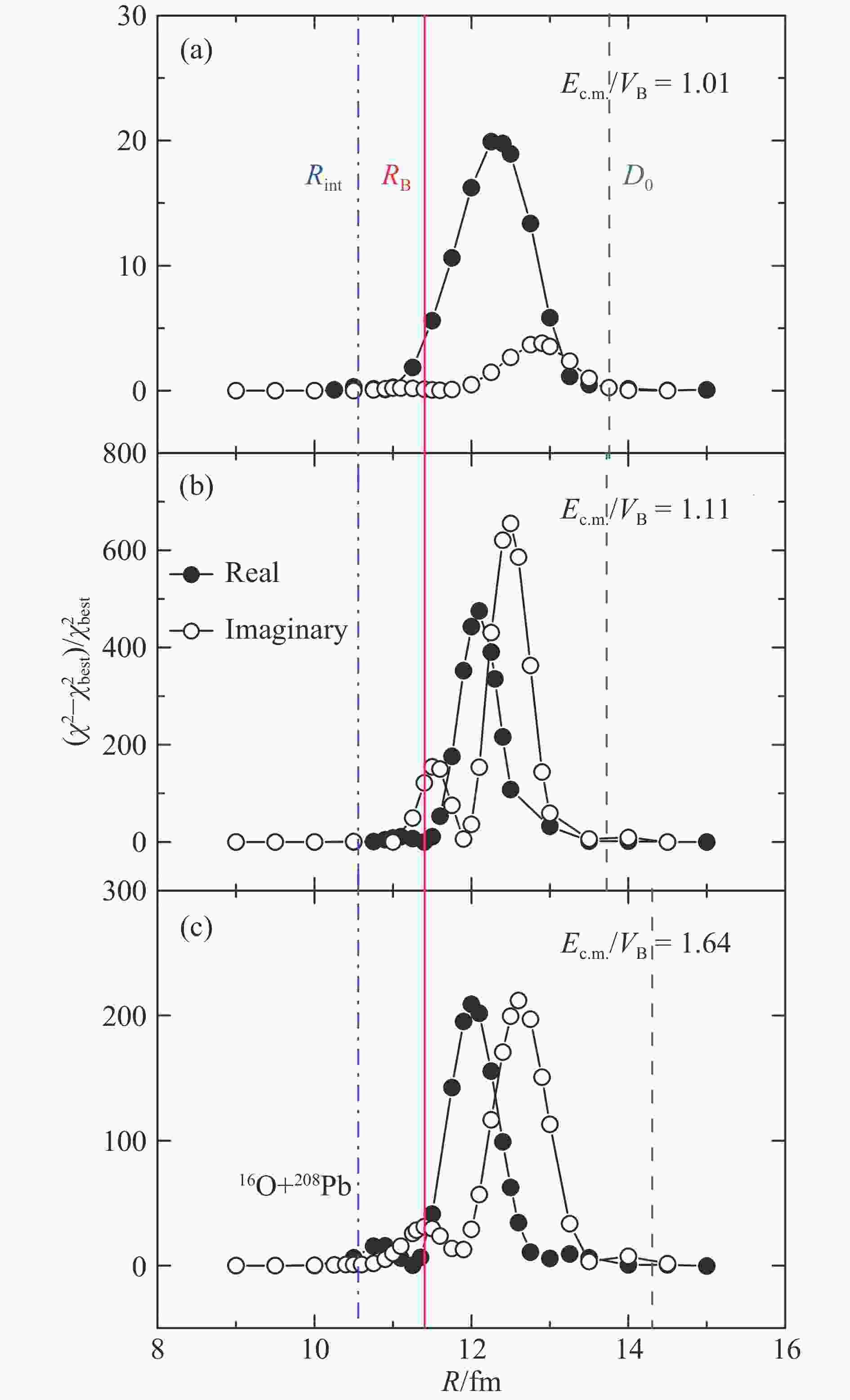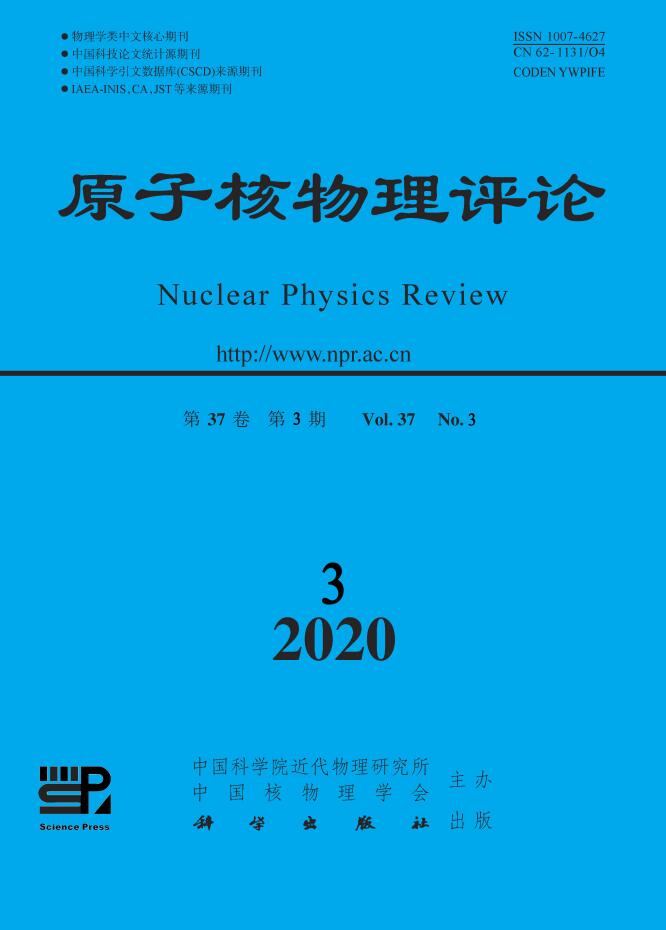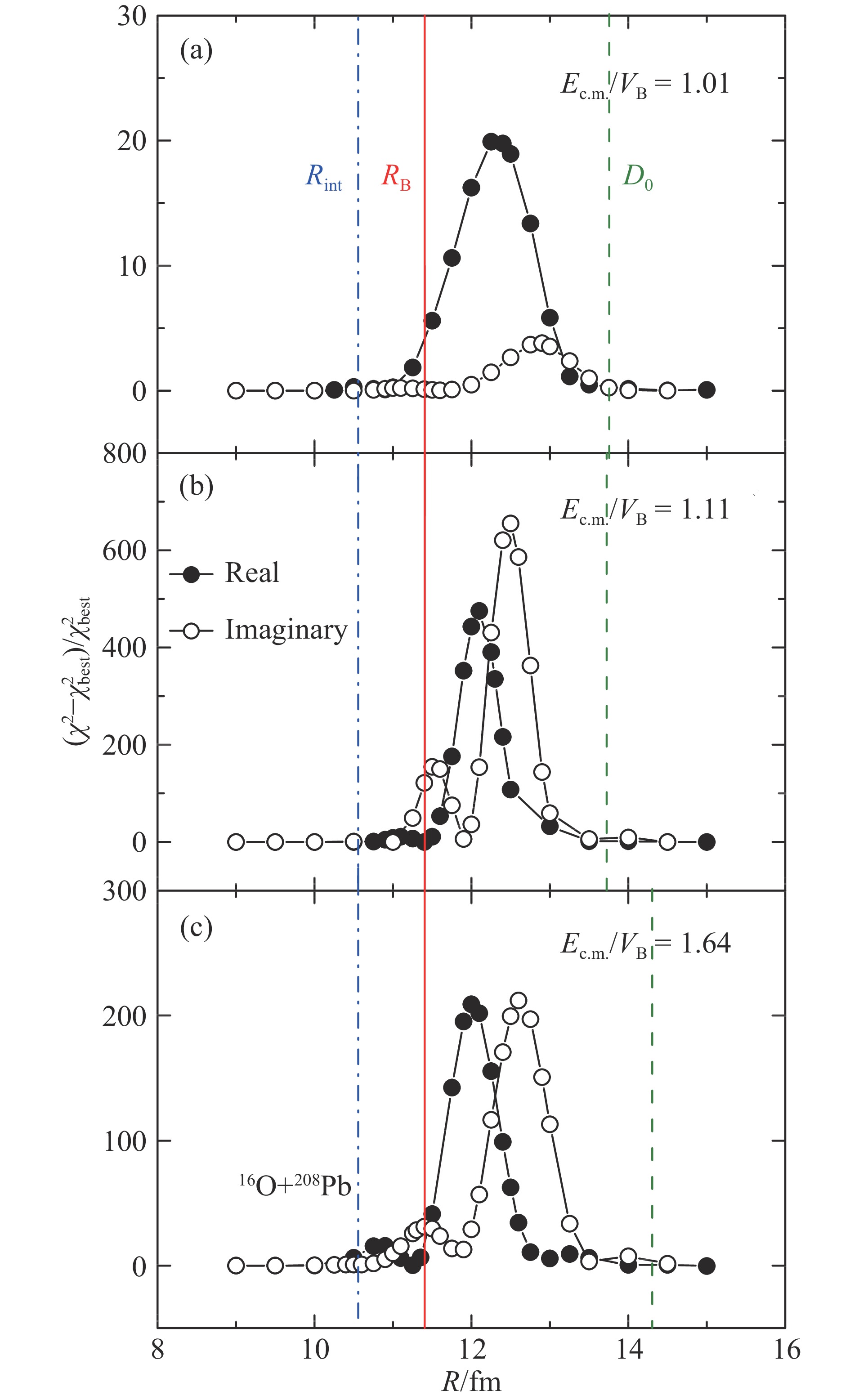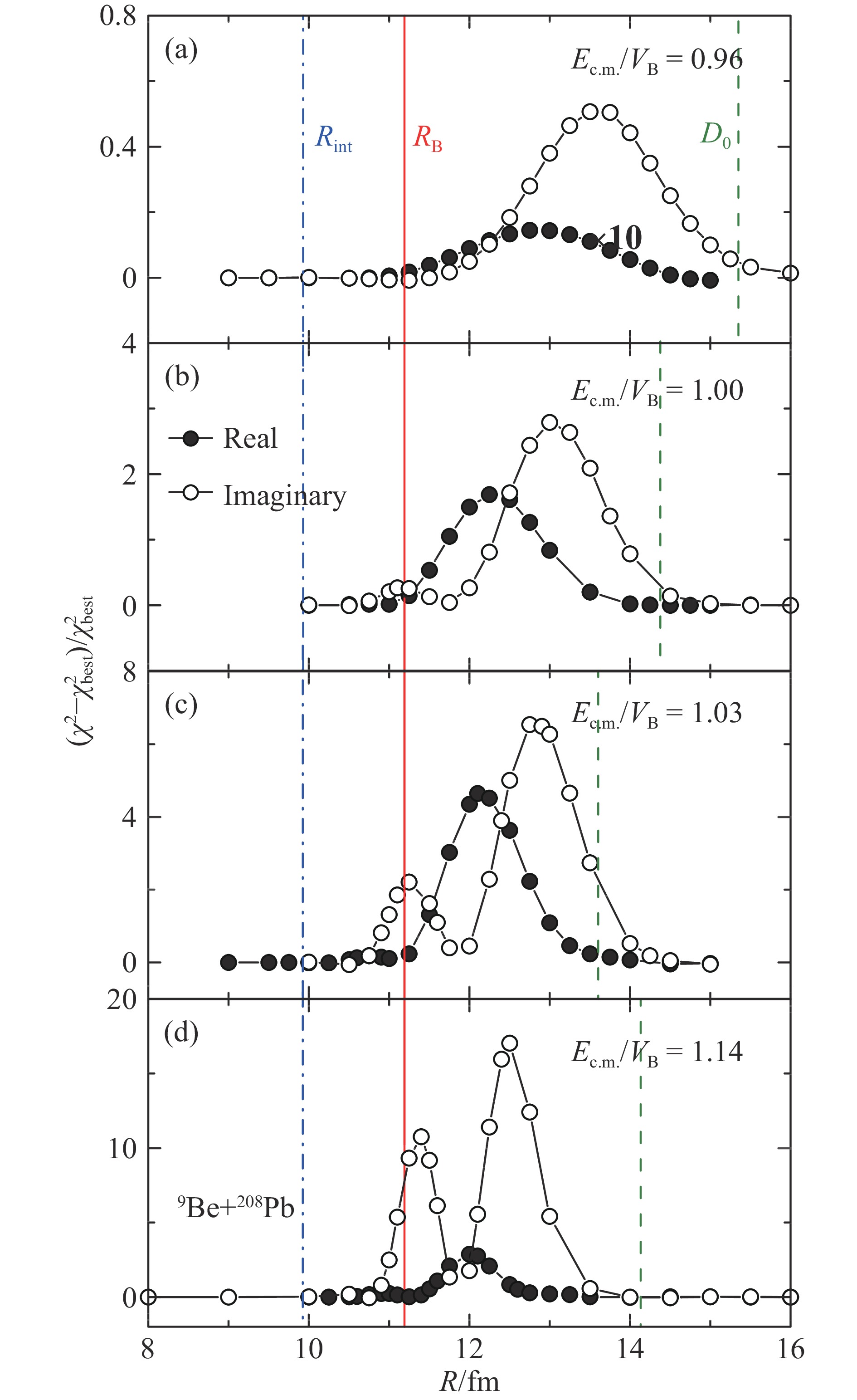-
Although elastic scattering is the simplest interaction process in the collision of two nuclei, it is the primary source of the information on the nuclear potential. With the long-term and systematic studies, some basic properties of the optical model potential (OMP) of heavy-ion reaction systems have been recognized, e.g., the threshold anomaly (TA), which was first observed in the scattering of 16O+208Pb[1] and refers to the energy dependence of the real and imaginary parts of OMP in the region around the Coulomb barrier. TA is characterized by the sharp decrease of the imaginary part of the potential as the bombarding energy decreases towards the Coulomb barrier, associated with a localized peak around the barrier in the real part. The dispersion relation[2], which arises from the causality principle, can be adopted to describe the connection between the real and imaginary potentials. The situation, however, is more complicated for the systems involving weakly bound nuclei, such as 6Li[3], 6He[4–7] and 9Be[8]. In these systems, a distinct manifestation of the OMP is observed, demonstrated as an increasing trend in the imaginary potential with energy decreasing below the barrier. Moreover, the application of the dispersion relation is still deserved a further investigation[6].
Since the OMP can be determined unambiguously only at the sensitive radius, it is crucial and necessary to investigate what radial regions of the nuclear potential can be well mapped before we make any discussions on the properties of OMP. The frequently used method to determine the sensitive region (SR) is to find the crossing-point radius of the potential[9-10]. However, such a sharply-defined sensitive radius is incompatible with the principles of quantum mechanics, and its value varies with different radial form factors adopted for the OMP[11]. As an alternative, the notch technique, which permits an intuitionistic investigation of SR, has been developed by Cramer et al.[12]. In the previous work[13], the sensitivities of the notch technique on the perturbation parameters, as well as the experimental data have been investigated in detail. Based on the results, in the present work, the notch method is further applied to study the qualities of the SR of the tightly (16O+208Pb) and weakly bound (9Be+208Pb) scattering systems, within the energy region near and above the Coulomb barrier.
-
The principle of the notch technique is to introduce a localized perturbation into either the real or imaginary radial potential, and move the notch radially through the potential to investigate the influence arising from this perturbation on the predicted cross section[12].
The nuclear potential is defined as
where the
$ V_0 $ and$ W_0 $ are depths of the real and imaginary parts of the potential with Woods-Saxon form$ f_i(r,a,R) $ ,where
$ R_i = r_{0i}(A^{1/3}_{\rm{P}}+A^{1/3}_{\rm{T}}) $ , and$ A_{\rm{P}} $ and$ A_{\rm{T}} $ represent the mass numbers of the projectile and target, respectively.Taking the real potential
$ V(r) $ as an example, the perturbation of the potential$ V_{\rm{notch}} $ can be expressed aswhere
$ R' $ and$ a' $ represent the position and width of the notch,$ d $ is the fraction by which the potential is reduced, and$ f_{\rm{notch}}(r, a', R') $ is the derivative Woods-Saxon surface form factor:Thus the perturbed real potential
$ V(r)_{\rm{pert.}} $ isThe perturbation for the imaginary potential can be derived with the same procedure.
When the perturbation is located in the sensitive region, where the predicted cross section depends strongly on the details of the potential, the calculated elastic scattering angular distribution will change greatly. This means, when compared with the experimental data, there will be a dramatic variation in the
$ \chi^2 $ value. Conversely, at positions where the evaluated cross section is not sensitive to the potential, the perturbation has little influence on the calculated angular distribution. By means of the notch technique, the sensitive region of the nuclear potential can be presented visually and explicitly.Based on our pervious work[13], the values of
$ d $ and$ a' $ are fixed at 1.0 and 0.05 fm, respectively, with the integration step size$ dr $ kept at 0.01 fm. The Woods-Saxon radial form factor is adopted for the nuclear potential. All the optical model (OM) calculations in the present work are performed with the code$ {\texttt{FRESCO}}$ [14]. The reduced radius$ r_0 $ and diffuseness parameter$ a $ of the OMP are fixed at 1.25, 0.65 fm for the 16O+208Pb, and 1.24, 0.63 fm for the 9Be+208Pb, leaving the depths of the real and imaginary parts to be extracted by fitting the elastic scattering angular distributions.The radial sensitivities of 16O+208Pb and 9Be+208Pb at some typical energies are shown in Figs. 1 and 2, respectively. As references, several important radii and distances are labeled in the figures, e.g., the radius of the Coulomb barrier
$ R_{\rm{B}} $ , the radius of the nuclear potential$ R_{\rm{int}} $ , as well as$ D_0 $ , at which the nuclear force begins to take effect, defined as where the$ {\rm{d}}\sigma_{\rm{el}}/{\rm{d}}\sigma_{\rm{Ru}} $ drops to 0.98 from the unity.
Figure 1. (color online) The sensitivity functions for the real part (full circle) and imaginary part (hallow circle) potentials for 16O+208Pb at some typical energies. The experimental elastic scattering data are taken from Refs. [15–17]. The height of the Coulomb barrier
$V_{B}$ is fixed at 73.39 MeV. The vertical solid, dashed, and dash-dotted curves denote the positions of the Coulomb barrier,$D_0$ and$R_{\rm{int}}$ , respectively. See text for the detail.According to the results, one can find that all the radial SRs locate between the
$ R_{\rm{int}} $ and$ D_0 $ , indicating that the nuclear interior can not be probed by the heavy-ion-heavy-ion elastic scattering at low energies. Meanwhile, SR becomes broader as the bombarding energy decreases, demonstrating that the sensitivity of the experimental data on the details of the nuclear potential turns to be weaker, due to the effect of the Coulomb repulsion. It can be confirmed further by the variations of the relative$ \chi^2 $ values, which become larger with the bombarding energy increases.On the other hand, two distinct peaks are present in both the real and imaginary parts within the above barrier energy region. The amplitude of the inner peak decreases rapidly with the energy going down to the sub-barrier, especially for the real part, the inner peak of which is too small to be recognized in the lower energy region. Moreover, the position of the inner peak almost keeps fixed, having no dependence on the bombarding energy: for the real part, the inner peak lies inside of
$ R_{\rm{B}} $ , while that of the imaginary part locates around$ R_{\rm{B}} $ . Therefore the inner peak should be responsible to the process of the barrier penetration, i.e., the inner peak of the real part corresponds to the resonance scattering process, and that of the imaginary part is arising from the fusion reaction. With the energy decreasing towards the barrier, the probability of the barrier penetration reduces, leading to the inner peak becomes weak in the lower energy region. The outer peaks, however, locate away from$ R_{\rm{B}} $ . Thus they should be mainly responsible for the surface interaction, i.e., the direct interaction process. Moreover, the position of the direct reaction peak of the real part always locates inside, about 0.7 fm, of that of the imaginary part, indicating that the imaginary potential owns a larger SR than that of the real potential.The energy dependence of the radial SRs (position of the peak) of both the 16O+208Pb and 9Be+208Pb systems is shown in Fig. 3, where the error bars reflect the width (sigma) of SR. It can be seen that in the above barrier region, the positions of the direct interaction peaks (
$ SR_{\rm{DR}} $ ) locates around the strong absorption radius ($ R_{\rm{sa}} $ ), corresponding to the radius where the observed elastic scattering cross section has fallen to one-fourth of the Rutherford value[18]. In the sub-barrier region, however, the variation trend of$ SR_{\rm{DR}} $ is compatible with closest approach in the Coulomb field$ D_{\rm{min}} $ , as shown by the solid curve. In the case of head-on collision,$ D_{\rm{min}} $ is expressed as$ 2Z_1Z_2e^2 $ /$ \mu v_{\rm{lab}}^2 $ , where$ Z_1 $ and$ Z_2 $ are the charge numbers,$ \mu $ is the reduced mass number,$ v_{\rm{lab}} $ is the incident velocity in the laboratory frame. Therefore, the energy dependence of the location of SR$ _{\rm{DR}} $ can be described by a simple expression, as
Figure 3. (color online) Energy dependence of the SRs of (a) 16O+208Pb and (b) 9Be+208Pb. The full and hallow circles represent results of the surface interaction of the real (real
$_{\rm{DR}}$ ) and imaginary (imaginary$_{\rm{DR}}$ ) parts, respectively. The full and hallow squares denote the inner SRs of the real (real$_{\rm{F}}$ ) and imaginary (imaginary$_{\rm{F}}$ ) potentials. The triangles are the$R_{\rm{sa}}$ extracted from the experimental data. And the solid curves represent the theoretical$D_{\rm{min}}$ .The positions of the inner SRs (
$ SR_{\rm{F}} $ ), which corresponds to the barrier penetration process, locates around the Coulomb barrier, and can be expressed as$ SR_{\rm{F}} = R_{\rm{B}} $ . -
In summary, the notch technique was applied to study the radial SRs of the tightly and weakly bound systems. The origins of the peaks present in the sensitivity functions are identified: the outer peak corresponds to the surface interaction, while the inner peak is arising from the Coulomb barrier penetration process. Thus, the shape scattering and resonant scattering can be disentangled, and the information of the Coulomb barrier, such as the barrier radius, can be provided. Moreover, the systematic energy dependence of SR were found for both the tightly and stable weakly bound systems: in the above barrier region, SR is equal to
$ R_{\rm{sa}} $ ; while below the barrier, SR can be described by$ D_{\rm{min}} $ . In consideration of the significance of the energy dependence of SR in the studies of OMP, it is strongly desired to make a further investigation with the notch technique in a wide range of systems, to obtain a global and universal understanding on the properties of the interaction potentials, especially for the exotic nuclear systems.
Energy Dependence of the Radial Sensitivity
doi: 10.11804/NuclPhysRev.37.2019CNPC25
- Received Date: 2019-12-28
- Rev Recd Date: 2020-03-20
- Available Online: 2020-09-30
- Publish Date: 2020-09-20
-
Key words:
- optical model potential /
- sensitive region /
- energy dependence /
- tightly bound nuclear system /
- weakly bound nuclear system
Abstract: With the application of the notch technique, the radial sensitive regions for the tightly bound system 16O+208Pb, and weakly bound system 9Be+208Pb were investigated. It is the first time that the shape and resonant scattering can be identified from the sensitivity functions. Moreover, strong energy dependence of sensitive regions were found for both the tightly and stable weakly bound systems: in the above barrier region, the sensitive region varies around the strong absorption radius; while below the barrier, the behavior of sensitive region is close to that of the closest approach in the Coulomb field.
| Citation: | Lei YANG, Chengjian LIN, Huiming JIA, Dongxi WANG, Feng YANG, Fupeng ZHONG, Shanhao ZHONG, Nanru MA, Peiwei WEN. Energy Dependence of the Radial Sensitivity[J]. Nuclear Physics Review, 2020, 37(3): 595-599. doi: 10.11804/NuclPhysRev.37.2019CNPC25 |
































































 甘公网安备 62010202000723号
甘公网安备 62010202000723号 DownLoad:
DownLoad:

